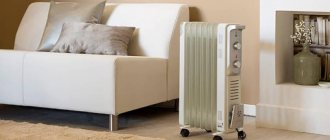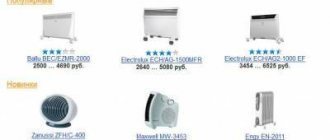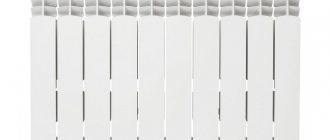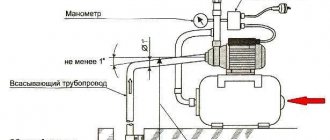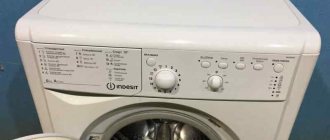During the cold season, many people spend a decent amount of time in unheated garages and outbuildings such as barns.
To make your stay as comfortable as possible, you should consider purchasing equipment such as a heater.
There are quite a lot of similar devices on sale today - they differ from each other in operating principle, overall dimensions, fuel used and a number of other parameters.
To shop for the most suitable equipment, read our review of the best garage heaters.
Rating of the TOP 10 best garage heaters for 2021
| TOP 3 best garage heaters by price/quality for 2021 | ||
| 1 | Ballu BIH-AP4-1.0 | Find out the price |
| 2 | RESANTA TVK-2 | Find out the price |
| 3 | Solar gas GII-2.9 | Find out the price |
| TOP 3 best infrared heaters for the garage | ||
| 1 | Ballu_BIH-LM-15 | Find out the price |
| 2 | Almac IK8 | Find out the price |
| 3 | Ballu BIH-L-3.0 | Find out the price |
| TOP 2 best heat guns for the garage | ||
| 1 | RESANTA TEPK-2000K | Find out the price |
| 2 | Ballu BHDP-20 | Find out the price |
| TOP 2 best oil heaters for garages | ||
| 1 | Electrolux EOH/M-6157 | Find out the price |
| 2 | RESANTA OMM-7N | Find out the price |
Water batteries
This type of heating is very labor-intensive to organize.
Already at the planning stage you will need to think through a lot of details. Indeed, in addition to the heat source, you need a system of pumps and pipes through which hot water will circulate. And this will inevitably entail the purchase of an expansion tank with batteries. In addition, plain water cannot be used. It must contain antifreeze to prevent freezing in winter. Equipping your garage with water heating only makes sense if you plan to spend a lot of time here. Or it is a structural part of a house that already has a central heating system. Then the garage room can be equipped with a water heater for uniform distribution of warm air.
Which garage heater should you choose?
When choosing a heater, special attention should be paid to the area of the room for which it is purchased:
- For small garages, the best option would be heat fans, which heat up quickly enough and immediately fill the room with warm air. For example, RESANTA TEPK-2000K (2 kW).
- For larger garages (from 20 sq.m.), it is better to purchase an infrared heater. For example, Ballu BIH-L-3.0.
- For large hangars that house multiple vehicles, the Ballu BHDP-20 is the best option.
- If you want to save money, it is better to purchase a gas heater. They are considered more economical and safe. Among those presented is Electrolux EOH/M-6157.
Oil furnaces
The room heats up much faster when using waste oil.
One spark is enough to ignite the flame. And the heat transfer is many times higher. However, this is also an unsafe option. Usually oil is burned in small ovens that you can make yourself. But even if such a potbelly stove (or small boiler) is reliable, liquid fuel may fail. In pursuit of cheapness, only used oil is used for heating, which must first be drained and allowed to settle. Of course, no one carries out any additional cleaning procedures. However, water accidentally getting into the oil or a drop of antifreeze on the walls of the boiler can cause dangerous consequences. When the oven is in operation, hot oil may begin to “shoot” in different directions. These fiery sparks can seriously burn and cause a fire. Sometimes owners take such a risk, because buying diesel fuel for heating is expensive. In this case, you need to keep an eye on the stove in the garage all the time.
Basic criteria for choosing a heater for a garage
Oil, gasoline and other flammable liquids are typically stored in the garage. Therefore, when choosing a heater, special attention should be paid to safety.
Oil-based ones are considered the safest, but they take a long time to warm up and heating the room to normal temperature will also take a long time.
Heat guns will do the job much faster. They are equipped with a coil that heats up in a matter of seconds and a fan that immediately begins to distribute heat in the room.
However, such heaters are less safe and require proper location: there should be no flammable substances nearby, and the heaters themselves cannot be covered with anything.
In any case, each heater must have the necessary certificates confirming the safety of the unit.
An important characteristic is the power consumption of the heater; in most of them at maximum operating mode it is 2000 W.
Practical implementation of heating a garage using an electric boiler
At the very beginning, when heating the garage with electricity, you need to choose the installation location for the boiler and radiators. The space should be as open as possible and not interfere with the use of the garage equipment itself, including opening the car doors, or raising its trunk and hood. Next comes the selection of a heating device in the store. Even for a garage of 20 m², a boiler of 1 kW and the cheapest pump will be enough, as long as it can connect and withstand the circulation of hot water through pipes with an internal diameter of 15–20 mm, which will be used to connect the entire system. Plus, you will need an expansion tank and the radiator itself.
Of the specific recommendations, the electric boiler “Economy EVP-3 KW”, costing only 1800 rubles, looks good in this regard. Don't look at large kilowatt/hour values. It doesn't constantly spin electricity. The principle is this: the boiler heats the liquid in the system to the set maximum temperature. Turns off. As long as the heat exchanger is cooled within certain limits, it does not react. As soon as the degrees fall below the bar, it is activated and again raises the temperature of the liquid.
You don’t have to worry about choosing a specific pump either. All circulation options with a consumption of up to or equal to 100 W, located in the price range from 1500 to 2000 rubles, are suitable.
An expansion tank is absolutely necessary so that the system does not fall apart at one nasty moment. You can come up with it yourself - it’s just a container attached to a hot water exchange system. Its main function manifests itself when the liquid expands as a result of heating - the excess goes into this tank. It is better and easier to buy ready-made solutions for such a vessel, equipped with the necessary pipes and adapters. A 2 liter model is quite enough. For example, from the company LadAna, for less than 500 rubles. As for the pipes themselves, it is better to use metal versions or heat-resistant plastic.
If there is no opportunity or desire to buy radiators, then use a homemade bundle of pipes. There is only one principle here - that the maximum amount of hot water be distributed over a larger surface. Although there are neat industrial heat exchangers on sale. They are mainly made of segment modules. A couple of such assemblies, each one meter long, will fully meet the needs of the average garage.
The boiler itself must be connected to the power line through thick copper wires and good circuit breakers at phase and zero, with limits of 25 A. In parallel, a pump is also connected to the power supply. Another nuance related to connecting the latter, but concerning water, they try to put it on the reverse of the system. This is done so that it works at lower fluid temperatures and does not overheat. One more thing. Without a separately removed and mounted “ground” in addition to the “zero”, such powerful equipment simply cannot be used, this applies to both the boiler and the pump.
Customer Reviews
Yulia M.
Ballu BIH-AP4-1.0
Careful. Almost invisible under the ceiling. We took it to maintain heat in the living room of a country house. Pleasant sensations. So far we're happy. Disadvantages: The rotating mechanism has a large pitch, it is impossible to adjust it to the desired radius, I’ll say right away that it’s not critical. And I would like more description in the instructions. Comment: In principle, a normal heater, we bought it specifically for the off-season, and immediately bought a regulator for it. Heating is felt throughout the room, not just in spots, as from heating. The only thing is that when I bought it, I couldn’t find information about whether it can be used with stretch ceilings, we are planning to make ceilings, but I would like to clarify. I won’t say anything about power saving, because we’ve been using it for less than a month and the receipt for the electricity hasn’t arrived yet. I am attaching a photo, everything is temporarily connected. We will do repairs and handle everything more carefully.
Alexander P.
RESANTA TVK-2
Advantages: 1. Powerful flow of warm air, heats well. 2. Beautiful design, compact size, and has a carrying handle. 3. There is a rotation mode. 4. Temperature and power can be adjusted. 5. There is protection against capsizing and overheating. Disadvantages: 1. After 2 weeks of operation, clicks appeared that occur when the direction of rotation of the heater changes. It started to get tense. If it doesn’t stop straining or the clicking doesn’t stop, then I’ll take it in for repair) 2. There’s not enough separate button or switch to turn it on and off on the front panel. Turning it on and off using a button would be more convenient than turning the mode switch. 3. A dust filter probably wouldn’t hurt, but it’s not currently in fashion among manufacturers, and maybe it’s not necessary. Comment: Bought as additional heating for home under a computer desk standing by the window. It copes with the task. There was no smell either the first time it was turned on or the subsequent ones. PS: After using it several times, it stopped clicking on its own. Apparently something fell into place)
Alexander Nezvidsky
Solar gas GII-2.9
This heater heats just like a big expensive one, because the area of the ceramics and the gas outlet are the same, the whole difference is in the design and configuration, this heater does not have a gearbox (300-500) rubles and a hose 200 rubles, a regular gas one is suitable (one end We cut off the other one onto the gearbox and pull it onto the heater nozzle, I recommend squeezing it with a clamp for those especially nervous, although everything fits tightly anyway) it’s ready. The CO2 output is minimal and is safe with natural ventilation. I’m heating the garage, in an hour I can heat up 18 m/² to plus 16 with 0 outside the gate. Another 2 kW of wind helps with it in an hour 20 plus at 14 minus outside, it will still depend on the energy efficiency of your room, if you cannot achieve such indicators, think about insulating the room. By consumption: 18 liter composite cylinder with 14 liters of refill, enough for a week when using the heater 5-6 hours a day. Refilling 14 liters costs 430 rubles. A good thing
Valeria D.
Ballu BIH-LM-1.5
Very pleasant warmth, does not dry out the air! Large range of action. Three modes. Metal body. It's on 24/7 and doesn't overheat. Disadvantages: They brought the wrong one, but the S model, it is smaller in size. I'm afraid that its efficiency is less for the same power. It shines at night (but I'm used to it and it doesn't bother me) Short wire. I think it will heat 25 m2 only with good thermal insulation. Comment: I am writing a review specifically for this model (not S), since before ordering I had already purchased such a heater on the market. That’s why I wanted a second one, because I’m very pleased. I use it at my dacha, which is insulated “in places” - at night I just turn it on at 500 watts and direct it towards myself. I sleep under a cotton blanket and feel warm. The room is 12 meters high, if you turn it on at 1000 watts for a couple of hours, it’s hot. It’s convenient that you can just put it next to it and point it at yourself. This will not work with a convector and it heats worse even at a power of 2000 watts
Vladimir Rusakov
Almac IK8
Pros: The design is simple, laconic and at the same time attractive. There is a good choice of colors, for example, I have Almak IK 8 in wenge color, such a pleasant dark brown color, it looks very beautiful against the background of the wooden walls of the attic. There is also white, gold, silver and pine color. Good variety, you can choose one for any room. An interesting fastening in the form of a groove along the entire length and two pendants are inserted into it. Such a simple solution, a very practical heater i.e. you don’t need to measure the distance on the ceiling between the hangers: two hooks in the ceiling and then move the hangers under them and hang the heater. I bought it on the company’s website, on the official one, there are even detailed instructions and all the information on connection and operation. That is, even without seeing the product with your own eyes, you can fully evaluate it. Corresponds to the description. The color also matches. Everyone who comes to visit notices it and mistakes it for a lamp, but if it is turned on, it immediately becomes clear that it is a heater. Disadvantages: The fasteners did not fit into the groove right away. Perhaps there was an influx of paint or something else was in the way. I had to use a flathead screwdriver to pry it out a little there (made in Russia - finish it yourself with a hammer!). There were also minor abrasions on the case, although the packaging was not opened before me. Perhaps it’s the wenge color that gives away all the mistakes. In bright conditions the heaters would not be visible. Comment: There are the same heaters, only of a different size, but the design and everything is generally identical. You can choose one for any quadrature, I recommend taking a closer look at this option if you don’t want to pay dearly, but still need good performance.
Vlad Abramin
Ballu BIH-AP4-1.0
Advantages: 1) Convenience of mounting to the ceiling, and connecting to the wiring, everything is simple and clear. 2) Design Disadvantages: 1) Build quality (but maybe it’s just me, it started clicking, it was solved by disassembling the heater and squeezing some places with pliers); 2) Heating range across the width, and not just underneath. (Example: if you hang it over the bed, lengthwise, but closer to the feet, then after some time the legs will get hot, but the head will freeze; in length, it warms more or less normally, i.e., for example, if the bed is double, then and on the second part of the bed your feet will be quite warm) Comment: In general, it heats the area directly underneath perfectly, it also heats the sides along the length more or less, but not to the sides along the width. Additionally, I connected a Ballu BMT-1 thermostat to the heater. After about a few months, when it was working (heating, when the thermostat does not turn it off), something began to click inside, this does not affect the operation, but now you can’t leave it overnight because it’s loud, judging by the reviews it’s something with the expansion of the metal... In general, this can happen in all models of different companies. In comparison with an oil heater, this is of course better (the power is the same), both in terms of heating and convenience (it doesn’t take up too much space), but not the heating speed, which is slow. Especially if you come in winter and the house is icy, you need to wait at least an hour or two.
Andrey Karpovich
RESANTA TEPK-2000K
Advantages: — Small, takes up little space. — Quite a nice appearance — Lightweight — The cable, although a little short (about 1 meter), is quite enough for my needs — The case does not heat up — Easy to operate — 3 modes Disadvantages: — Lacks a timer — Weak flow Comment: At the time of writing I've been using it for 5 days now, I'm happy with everything. I bought it to heat a loggia (4 sq/m) since it is not insulated. Such an area is heated to a comfortable/room temperature in 15-20 minutes, taking into account that the approximate temperature in the room is +4 - +5. Please note, if you need to heat a room where the temperature is sub-zero or close to zero, then this mini-gun is unlikely to cope with this task, I advise you to take a more powerful model. Initially I didn’t expect much from a budget model, but in the end this model is quite enough for my modest needs
Vova B.
Electrolux EOH/M-6157
Advantages: New technology with accelerated heating. The surface is protected from mechanical damage. It has an interesting appearance, I would say even somewhat futuristic thanks to the round elements, built-in rollers for movement. This is the third year that this radiator has warmed the living room in the evenings and the children's room at night, a very positive impression. The oiler can work for hours without stopping or overheating and I can trust it, thanks to the presence of several safety levels at once. Well-thought-out wheels and a convenient handle allow the radiator to be moved between rooms in a matter of seconds, and in the summer it does not take up much space in the pantry, and the cord is hidden in the body of the radiator itself.
Nikolay S.
RESANTA TVK-2
Advantages: Low price, quickly warms up the room, 90° rotation, ceramic heating elements Disadvantages: The thermostat does not work well: at one adjustment level it can heat for a long time without turning off, or it may not turn on when it gets noticeably cold, as if there are tolerances of several degrees; The rotation around the axis does not stop when the mode is switched to the zero position, only disconnecting from the network Comment: As a heater - an excellent product: it heats quickly, consumes little, there was no smell As a climate control device - it is unlikely to be useful, it heats for a long time until it gets hot ( 24-25* at the heater level), then for a long time it does not warm up to noticeable coolness (20-21*)
Alexander S.
Ballu BHDP-20
Pros: I liked everything. The build quality is the size and most importantly how it works. I have several garages and it can be easily moved from one to another by the handle. The most important thing is that it works completely automatically. I set the desired temperature with the regulator and that’s it. It will turn on itself and turn off when the set temperature is reached. As soon as the temperature drops below the set one, it turns on again and so on until you turn it off or the diesel fuel runs out. Comment: When you turn it on in the garage, it is better to stick it out the door because the first exhaust will stink a little. Then it works in the room with virtually no odor. A 5-liter bottle is enough for a day to maintain the operating temperature in three garages - But not a whole day of work, but as needed .
Valentin N.
RESANTA OMM-7N
Advantages: Size, low power. Disadvantages: Lack of a shutdown button (there is one in the photo, in fact I don’t have one, only a light bulb, but they didn’t show it on the packaging either) Comment: Compact low-power oil heater, just what I was looking for for a balcony. Actual size 30x15x37 cm LxWxH No rollers, for me it doesn’t matter because... It is lightweight due to its compactness and has a handle for carrying. The power is enough to heat a small room (for me it’s a balcony) and at the same time not to overload the electrical wiring. I think it will be very suitable for those who were looking for a heater under the table, etc.
Leonard T.
Ballu BIH-L-3.0
Advantages: 1. The summer veranda is heated all over evenly, this is facilitated by the reflector located behind the heating lamp. 2. During use, it has not lost its attractive appearance: the steel case has not been deformed; The chrome grille, which protects against accidental contact with the heating element, has not rusted. Disadvantages: I had to go shopping to find a special telescopic tripod for installing the heater, because it was not included in the package. Comment: On the open veranda of my cafe you can not only have a tasty snack, but also warm up in cold weather; for this I installed a modern infrared heater, which gives visitors warmth from the moment it is turned on. I set the heating power depending on the air temperature to make it comfortable.
Use of general heating
The ideal situation is when the garage is located next to a private house or a public heating pipe. You can route the heating main into it. In the case of a city, everything is done through the appropriate services. In relation to home, it’s simpler - you need several radiators, connecting pipes and insulation for laying a heating main along the street. In the case of a private option, the central hot water supply line from the boiler is disconnected, into which an additional heating branch is built, as if extending it. Below are two options for inserting into the heating network of a house, depending on its type.
When connecting a garage to a citywide network, the connection is made by tapping (without breaking it!) into the hot water supply and return line. In general, it is better to entrust such a procedure for a municipal heating system to specialized organizations. It will not be much more expensive than the design of the insertion project itself, carrying out work on it and other nuances of execution.
Heating cables
Laying a heated floor in a garage is not always advisable, but in one situation such a design will be more than justified. We are talking about starting a car in cold weather - often a lot of problems are associated with this, and the presence of a heating cable will significantly simplify the task. In addition, you can lay the cable only under the car and turn it on only if you have problems starting the engine.
The machine must first be covered with a cover that will cover it completely - this will allow the thermal energy to be concentrated in one zone. The air will not move into the garage itself, so the level of heat loss will be minimized. This technique will allow you to quickly warm up the car even in severe frost.
Advantages and disadvantages of IR
Garage IR heater equipment, technical indicators and features of use have specific advantages and disadvantages.
Advantages:
- connecting equipment does not require large financial investments;
- the basic package consists of the necessary parts for installation;
- simple connection of an electric emitter;
- installation of gas equipment may require obtaining the necessary permit;
- the possibility of separate zones of the room, rather than the entire garage;
- modern models are protected against overheating of the surface and fire in the event of a fall.
Minuses:
- the power of household appliances is much reduced in order to obtain favorable heating conditions;
- the high cost of the device and the large number of Chinese counterfeits that fill the climate system market.
The IR heating system has no analogues. Compared to a standard heating radiator, they allow you to get instant heating even in a cold building. High efficiency and almost no significant disadvantages explain the popularity of infrared emitters.
We recommend: Features of heating a greenhouse with an infrared heater
YouTube responded with an error: The request cannot be completed because you have exceeded your quota.
- Related Posts
- Features of heating a greenhouse with an infrared heater
Electric convectors
The design of the device is simple. The heating element is a heating element - a high-resistance conductor packed in a housing. It is resistant to high temperatures. Modern radiators are more efficient due to additional parts on the body: wings, petals and blades. These designs are designed to increase the heat transfer area of the batteries.
The heating element heats up to 1000 degrees, and most of the heat enters the room without drying out the air. Oil and water radiators are significantly inferior to electric ones not only in the speed of heating the surrounding air, but also in regulating the humidity in the room.
Electric convector in the country.
Due to their compact size and relatively low weight, wall-mounted radiators are ideal for indoor use. The heater is quite compact - 40-45 cm in length. And narrow and slightly longer analogues with a height of 20 cm fit well into any interior design.
Wall-mounted convector in the interior of an apartment
Before choosing an electric heating system, you should learn more about its advantages:
- Batteries of this type do not create drafts.
- No regular inspection required. The equipment can operate in automatic mode.
- The thermostat measures the temperature in the room and, based on the data received, increases or decreases the power of the heater, which allows you to avoid wasting excess electricity.
- The heating element is reliably protected from overheating, so the electric heat supply system can be installed on any wall surface.
- Some batteries are equipped with moisture-resistant housings, which allows them to be used in areas with high humidity levels.
Modern design of electric heaters
- Modern radiators have a safe design: sharp corners and rounded parts. This prevents accidental injuries. This design of the device is relevant if there are small children and pets in the house.
- The convector can be safely installed in a nursery because it does not burn oxygen.
Electric convector in the interior of the apartment
Another parameter that is worth paying attention to when purchasing such radiators is quiet operation. Among the range of electric batteries there are models of wall heaters, additionally equipped with wheels or rollers
This is convenient when there is a need to move the radiator from place to place. Floor electric heaters are less mobile. Most often they are intended for a strictly defined location. Wall heating systems can be installed at a height of 30-50 cm from the floor
Among the range of electric batteries there are models of wall heaters, additionally equipped with wheels or rollers. This is convenient when there is a need to move the radiator from place to place. Floor electric heaters are less mobile. Most often they are intended for a strictly defined location. Wall heating systems can be installed at a height of 30-50 cm from the floor.
Silent electric convector
Popular models
The rating of popular models will allow you to make the right choice:
- The ATON modification Vektor 3 runs on liquefied gas. This compact, energy-independent floor convector is portable and suitable for heating small rooms. The range of automatically maintained temperatures is 13-18°C. The heat exchanger of the device and its combustion chamber are made of steel. Model specifications:
- dimensions – 54x59x25 cm;
- There is a closed combustion chamber inside;
- power is 3 kW;
- the unit weighs 22 kg and costs 206 dollars (13,390 rubles).
- The Hosseven HBS floor-standing gas heater has an open combustion chamber and can operate on mains and liquefied gas. The kit includes an Italian gas valve and a telescopic gas outlet. The device operates almost silently and is equipped with a steel combustion chamber and heat exchanger. Its technical characteristics are as follows:
- bottled gas consumption is 0.73 m³/h;
- main fuel consumption is 0.9 m³/h;
- dimensions – 62x68x26 cm;
- the device weighs 18 kg;
- it is designed for a power of 9 kW;
- the cost is 333 dollars (21,700 rubles).
- The Alpine Air gas convector series NGS-40 is mounted on the wall of the room. The device is equipped with a cast iron heat exchanger and a modernized POLIDORO burner. Inside there is a high-quality SIT type gas fittings. The convector is protected from freezing, has a thermostat and can perform self-diagnosis. Efficiency is above 90%. The burner has electronic ignition, and the steel body is coated with a protective powder coating. The technical specifications are as follows:
- the unit consumes 0.43 m³ of fuel per hour;
- its dimensions are 61x63x22 cm;
- the device weighs 30 kg;
- its power is 3.54 kW;
- The price of the heater is 332 dollars (21,600 rubles).
- Wall convector Varmann GLASSKON modification 65.450.720 has an attractive design and shut-off valves that allow you to connect the device to the heating system of the house. The outer panel is removable and comes in several decorative options. Technical characteristics of the device:
- working pressure up to 16 bar;
- it can heat the coolant up to 130 degrees;
- the price of the unit is 195 dollars (12,700 rubles).
Popular models also include Hosseven HP units and the Bartolini CALORAMA model of the FB5500 series. As you can see, the gas convectors presented differ in their characteristics, equipment and price, so that each consumer can choose a model that meets all requirements.
Basic requirements for electrical wiring
There are certain requirements regarding electrical wiring in garages. So for a major garage they use closed-type wiring.
When laying wires along walls, they must be insulated.
This can be done using boxes made of metal or plastic.
Exposed wiring is suitable for metal garages.
For exposed wiring, prepare flat wires. These include APPV , PPV , APPR .
They are attached to the wall using metal brackets.
Insulating boxes are placed on top of the wires. They need to be fastened with screws. The optimal distance between staples is about 0.5 m .
Strip the ends of the wires. Now they can be connected to the socket terminals.
When choosing wires , consider several important points:
- Calculate the cable cross-section taking into account the power of the devices that will operate in the garage. Now multiply the total power value by 1.2. After this, select the appropriate cable cross-section .
- Under no circumstances use wires with aluminum conductors, as they are often subject to mechanical damage.
- It is better to buy a cable with a reserve. The length of the wires when connecting to sockets and panels should be 10-15 cm greater than .
- Think about the number of outlets in your garage. In any case, you need to install at least 2 pieces. One of the sockets is needed to connect an electrical appliance, and the second is for an extension cord.
- It is necessary to provide switches for the inspection pit and the main lighting of the garage.
Read about how to make racks, shelves, a workbench and a car lift in your garage.

